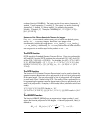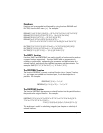
Page 5-23
Fractions
Fractions can be expanded and factored by using functions EXPAND and
FACTOR, from the ALG menu (‚×). For example:
EXPAND(‘(1+X)^3/((X-1)*(X+3))’) = ‘(X^3+3*X^2+3*X+1)/(X^2+2*X-3)’
EXPAND(‘(X^2)*(X+Y)/(2*X-X^2)^2)’) = ‘(X+Y)/(X^2-4*X+4)’
EXPAND(‘X*(X+Y)/(X^2-1)’) = ‘(X^2+Y*X)/(X^2-1)’
EXPAND(‘4+2*(X-1)+3/((X-2)*(X+3))-5/X^2’) =
ʳʳʳ‘(2*X^5+4*X^4-10*X^3-14*X^2-5*X+30)/(X^4+X^3-6*X^2)’
FACTOR(‘(3*X^3-2*X^2)/(X^2-5*X+6)’) = ‘X^2*(3*X-2)/((X-2)*(X-3))’
FACTOR(‘(X^3-9*X)/(X^2-5*X+6)’ ) = ‘X*(X+3)/(X-2)’
FACTOR(‘(X^2-1)/(X^3*Y-Y)’) = ‘(X+1)/((X^2+X+1)*Y)’
The SIMP2 function
Functions SIMP2 and PROPFRAC are used to simplify a fraction and to produce
a proper fraction, respectively. Function SIMP2 takes as arguments two
numbers or polynomials, representing the numerator and denominator of a
rational fraction, and returns the simplified numerator and denominator. For
example: SIMP2(‘X^3-1’,’X^2-4*X+3’) = { ‘X^2+X+1’,‘X-3’}.
The PROPFRAC function
The function PROPFRAC converts a rational fraction into a “proper” fraction,
i.e., an integer part added to a fractional part, if such decomposition is
possible. For example:
PROPFRAC(‘5/4’) = ‘1+1/4’
PROPFRAC(‘(x^2+1)/x^2’) = ‘1+1/x^2’
The PARTFRAC function
The function PARTFRAC decomposes a rational fraction into the partial fractions
that produce the original fraction. For example:
PARTFRAC(‘(2*X^6-14*X^5+29*X^4-37*X^3+41*X^2-16*X+5)/(X^5-
7*X^4+11*X^3-7*X^2+10*X)’) =
‘2*X+(1/2/(X-2)+5/(X-5)+1/2/X+X/(X^2+1))’
This technique is useful in calculating integrals (see chapter on calculus) of
rational fractions.


















